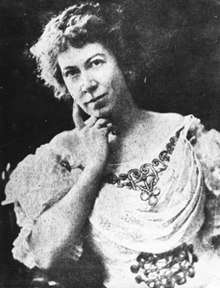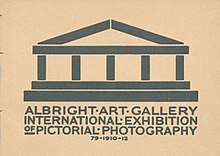Cornelia Bentley Sage Quinton
Cornelia Bentley Sage Quinton (1876–1936) was an American painter and curator. She was the director of the Albright Art Museum (later the Albright-Knox Art Gallery) in Buffalo, New York from 1910 through 1924. Upon her appointment as director on October 15, 1910 she became the first woman to serve as director of a major art museum in the United States.[1]
Cornelia Bentley Sage Quinton | |
|---|---|
 | |
| Born | Cornelia Bentley Sage October 3, 1876 Buffalo, New York |
| Died | May 16, 1936 (aged 48) Santa Barbara, California |
| Nationality | American |
| Education | Art Students League of Buffalo, Art Students League of New York, École du Louvre |
| Known for | Painting, Arts Administration |
| Spouse(s) | William Warren Quinton ( m. 1917) |
Life
Sage was born on October 3, 1876 in Buffalo, New York.[2] She attended the Art Students League in both Buffalo and New York City, and the École du Louvre in Paris, France.[2] Sage married William Warren Quinton on Oct 31, 1917.[3]
Quinton began working at the Albright Art Museum in May 1905. She became director of the museum in 1910 after the sudden death of Charles M. Kurtz. Quinton organized noteworthy exhibitions at Albright Art Museum such as the International Exhibition of Pictorial Photography in 1910, and the Exhibition of Contemporary American Sculpture in 1916.[1]
The International Exhibition of Pictorial Photography was the first photography exhibition held at an American museum.[4] The Exhibition of Contemporary American Sculpture featured more than 800 works of sculpture by 168 contemporary American artists.[5]

In 1920 Quinton received Cross of the Legion of Honor from France for her work promoting French art during WWI.[3]
Quinton left the Albright Art Museum in 1924 to become the director of California Palace of the Legion of Honor,[1] a position she held until 1930.[2]
Quinton died on May 16, 1936 in Santa Barbara, California.[2]
Legacy
In 2002 Quinton was honored by the WNY Friends of the National Women's Hall of Fame.[6]
References
- "Cornelia Bentley Sage Quinton". Albright-Knox Art Gallery. Retrieved 14 June 2018.
- "Cornelia Quinton (1876 - 1936)". askART. Retrieved 15 June 2018.
- "Quinton, Cornelia B. Sage (1876–1936)". Dictionary of Women Worldwide: 25,000 Women Through the Ages. Encyclopedia.com. Retrieved 14 June 2018.
- "International Exhibition of Pictorial Photography". Albright-Knox Art Gallery. Retrieved 15 June 2018.
- "Exhibition of Contemporary American Sculpture, Held Under the Auspices of the National Sculpture Society". Albright-Knox Art Gallery. Retrieved 15 June 2018.
- "Book of Lives & Legacies". National Women's Hall of Fame. Retrieved 15 June 2018.